-
United States -
United Kingdom -
India -
France -
Deutschland -
Italia -
日本 -
대한민국 -
中国 -
台灣
-
Ansys si impegna a fare in modo che gli studenti di oggi abbiano successo, fornendogli il software gratuito di simulazione ingegneristica.
-
Ansys si impegna a fare in modo che gli studenti di oggi abbiano successo, fornendogli il software gratuito di simulazione ingegneristica.
-
Ansys si impegna a fare in modo che gli studenti di oggi abbiano successo, fornendogli il software gratuito di simulazione ingegneristica.
-
Contattaci -
Opportunità di lavoro -
Studenti e Accademici -
Per Stati Uniti e Canada
+1 844.462.6797
ANSYS BLOG
December 5, 2022
Stray Light in a Head-Up Display Application with Speos and Zemax
Head-up display (HUD) systems are increasingly prevalent in the automotive industry, as they allow a driver to view relevant data — speed, mileage, navigation, etc.— without looking away from the road.
When optimizing an optical system such as a HUD, it is important to consider stray light paths. Stray light is any unintended light that makes its way to a detector or is perceived by a user. There are several sources of stray light in any optical system, but these generally fall into two categories:
- Stray light from optical components (ghost reflections off coatings, scattering from rough surfaces, etc.).
- Stray light from non-optical components (reflection and scattering from opto-mechanics, etc.).
Ansys’ optics solutions provide multiple tools that work seamlessly together to provide a complete solution for simulating — and, more importantly, determining how to mitigate — stray light in any optical design.
Stray Light Caused by Optical Properties and Components
Some paths are the result of internal issues such as ghosting, which can be caused by the incident light reflecting onto the windshield from multiple planes. A windshield is made of safety glass, which typically has three layers. The inside and outside layer are tempered glass while the middle layer is polyvinyl butyral (PVB). This multilayer glass is sensitive to the angle the light hits it and can cause some unintended reflections, also known as ghosting. Careful selection of mirror angles, materials, coatings, and position can minimize these effects.
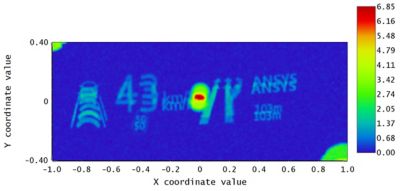
Ghosting from windshield, hotspot from sun.
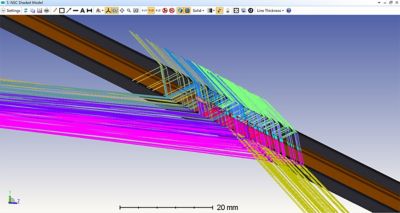
Total internal reflection (TIR) occurring between layers in the windshield, creating undesired reflections to the driver.
External sources, such as the sun or headlights, can cause undesired impacts on the optical system. To mitigate the effects of glare from headlights, manufacturers can use coatings. The sun can cause two issues: driver annoyance and picture generation unit (PGU) damage. Light traps — mechanical catches for undesired light paths — can be employed during the opto-mechanical phase.
Another common approach is a cold mirror. This a substrate coated with multiple layers of materials to reflect the visible light while allowing infrared light to pass through it. Basically, it creates a mirror that acts as a bandpass filter. This can reduce damage to the PGU.
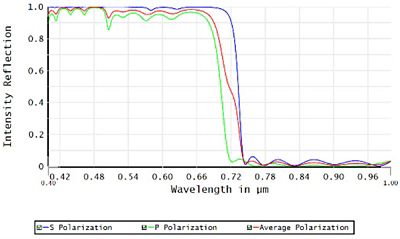
A 47-layer coating allowing the mirror to behave like a bandpass filter, creating a cold mirror.
Stray Light Caused by Non-Optical Components
After optimizing the mirror system in Ansys Zemax OpticStudio, we can then use Ansys Speos to determine worst-case sun positions for stray light for not just in the HUD system, but the surroundings as well.
For example, we can perform a system-level analysis on the impact of stray light falling on the adjacent mechanical housing, bezel, or dashboard. Glare from any of these objects can cause a hindered view of the safety-critical information from the HUD.
Upon discovery of the stray light conditions, we can validate the visual experience from the driver’s eye position to determine how obstructive or annoying the reflection is. Using graphics processing unit (GPU) simulation, we can quickly experience the physics-based result. Edge cases — such as entering and exiting a tunnel — can also be explored without stepping outside.
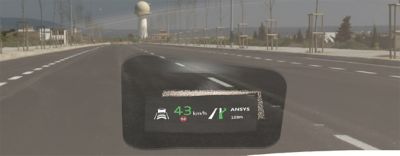
From there, if mirror coatings or mirror trimming don’t cut it, material choice becomes important for the housing of the HUD system. Using more diffuse, higher-absorbing materials will help diminish the amount of perceived glare by the driver when focusing on the road ahead.
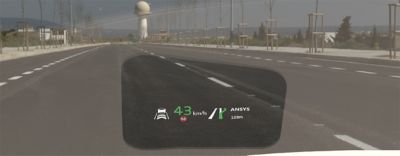
Stray light caused by HUD bezel.
In order to keep the drivers’ eyes fixed on the road ahead, HUD systems play a strategic role in displaying safety-critical information that is both visible and legible, while not introducing additional artifacts that might affect the driver’s overall visibility. With OpticStudio and Speos together, these goals can be achieved much sooner in the design life cycle, eliminating the chance that these undesired scenarios can occur.
Experience the power of Ansys optical design and simulation software for yourself by requesting a free trial today:










